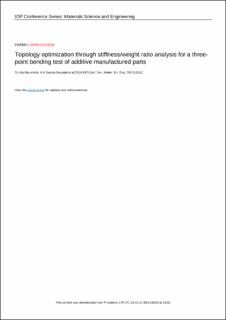| dc.contributor.author | Garcia-Granada, Andres | |
| dc.contributor.author | Catafal-Pedragosa, Joan | |
| dc.contributor.author | Lemu, Hirpa G. | |
| dc.date.accessioned | 2023-02-02T09:52:58Z | |
| dc.date.available | 2023-02-02T09:52:58Z | |
| dc.date.created | 2019-12-03T21:22:48Z | |
| dc.date.issued | 2019 | |
| dc.identifier.citation | Garcia-Granada, A. A., Catafal-Pedragosa, J., & Lemu, H. G. (2019, November). Topology optimization through stiffness/weight ratio analysis for a three-point bending test of additive manufactured parts. In IOP Conference Series: Materials Science and Engineering (Vol. 700, No. 1, p. 012012). IOP Publishing. | en_US |
| dc.identifier.issn | 1757-8981 | |
| dc.identifier.uri | https://hdl.handle.net/11250/3047942 | |
| dc.description.abstract | Topology Optimization (TO) is a technique that allows for increasingly efficient designs and its objective is to maximize the performance of mechanical systems or structure in a variety of fields. Attempts to employ TO for parts manufactured with conventional methods such as casting, forging, injection moulding, CNC machining and the like could not lead to desired optimum results due to the existing manufacturing constraints regarding geometrical complexity. Currently, additive manufacturing (AM) techniques allow the fabrication of more complex shapes which in principle will lead to improved performances through application of the TO concept. This study focuses on structural optimization of additive manufactured parts of thermoplastic parts based on analysis of the stiffness/weight (mass) ratio for a beam subjected to a three-point bending load. The experimental work is done on optimization of parts manufactured by Fused Deposition Modelling (FDM) technology and finally compared with an identical model manufactured using Polyjet 3D printer. Different TO software are compared to conduct the optimization, and a module of SolidWorks 2018 from Dassault Systems is chosen for the topology optimization for the final experiment. The study focuses on the results on stiffness/mass ratios, paying attention to the influence of different printing parameters on the test results. An increase of stiffness/weight ratio of 31.7% was predicted by software while experiments showed an increase of just 27.04%. | en_US |
| dc.language.iso | eng | en_US |
| dc.publisher | IOP Publishing | en_US |
| dc.relation.uri | https://iopscience.iop.org/article/10.1088/1757-899X/700/1/012012/pdf | |
| dc.rights | Navngivelse 4.0 Internasjonal | * |
| dc.rights.uri | http://creativecommons.org/licenses/by/4.0/deed.no | * |
| dc.title | Topology optimization through stiffness/weight ratio analysis for a three-point bending test of additive manufactured parts | en_US |
| dc.type | Peer reviewed | en_US |
| dc.type | Journal article | en_US |
| dc.description.version | publishedVersion | en_US |
| dc.rights.holder | The authors | en_US |
| dc.subject.nsi | VDP::Teknologi: 500 | en_US |
| dc.source.pagenumber | 10 | en_US |
| dc.source.volume | 700 | en_US |
| dc.source.journal | IOP Conference Series: Materials Science and Engineering | en_US |
| dc.source.issue | 1 | en_US |
| dc.identifier.doi | 10.1088/1757-899X/700/1/012012 | |
| dc.identifier.cristin | 1756296 | |
| cristin.ispublished | true | |
| cristin.fulltext | original | |
| cristin.qualitycode | 1 | |

